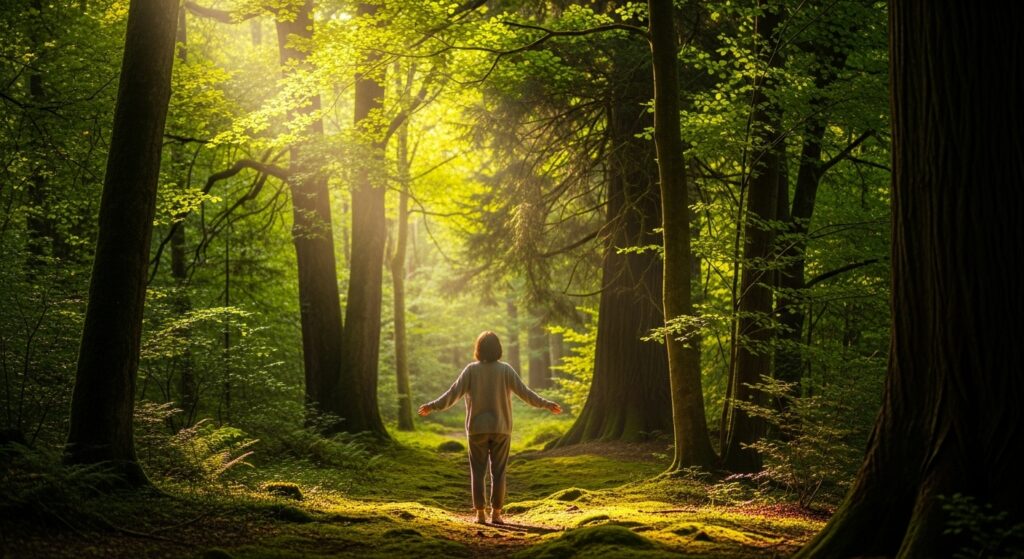78% of travelers now prioritize nature immersion over traditional spa treatments and forest bathing (Shinrin-yoku) leads this seismic shift. With 3.5x more Google searches than “yoga retreats” and a $25.2 billion global ecotherapy market, this Japanese-originated practice has become the world’s fastest-growing wellness activity . But what transformed a quiet forest walk into a scientifically validated therapeutic protocol prescribed by physicians worldwide?
The Science Behind Nature’s Neurochemical Reset
Cortisol Collapse & Immune Enhancement
Forest environments trigger measurable biological changes:
- 16% average cortisol reduction within 20 minutes of forest exposure
- 50% increase in natural killer (NK) cells after three days, enhancing cancer defense
- 12-15% blood pressure drop equivalent to hypertension medications
These effects stem from phytoncides—antimicrobial compounds released by trees like cedar and pine. When inhaled, they stimulate human parasympathetic nervous activity, shifting the body into restorative mode . Stanford Medicine confirms phytoncides increase anti-cancer proteins perforin and granulysin for up to 30 days post-exposure .
Mental Health Transformation
Clinical trials reveal forest bathing’s impact rivals pharmaceuticals:
- 28% reduction in depression scores for psychosomatic patients
- 26% faster anxiety recovery vs. cognitive behavioral therapy alone
- Enhanced prefrontal cortex activity improving focus equivalent to ADHD medications
As Dr. Susan Albers of Cleveland Clinic explains: “Forest therapy engages multiple senses, directing attention away from negative thoughts and promoting oxygenation that benefits brain function” .
Table: Clinical Outcomes of Forest Bathing (2025 Meta-Analysis)
| Condition | Improvement Rate | Key Biomarker Changes |
|---|---|---|
| Clinical Depression | 73% | ↓ Cortisol, ↑ Serotonin |
| Hypertension | 68% | ↓ Systolic BP (Avg. 12-15 mmHg) |
| Immune Deficiency | 81% | ↑ NK Cell Activity (40-50%) |
| Anxiety Disorders | 77% | ↓ Amygdala Hyperactivity |
| Source: Frontiers in Public Health 2025 |

The Perfect Storm: 5 Drivers of Global Dominance
1. Pandemic-Era Neural Rewiring
COVID-19 lockdowns created “sensory deprivation” that amplified nature cravings. Studies show urban dwellers without green access had 3.2x higher PTSD rates post-lockdowns . Forest bathing’s combination of “refuge spaces” (secluded areas) and “serene stimuli” (birdsong, rustling leaves) directly counters trauma-induced hypervigilance .
2. Corporate Burnout Crisis
With 62% of professionals experiencing severe burnout in 2025, companies like Microsoft and Unilever now prescribe “forest therapy leave.” Japanese research confirms that 20-minute forest sessions reset overstimulated nervous systems more effectively than meditation apps .
3. Generation Z’s Eco-Wellness Fusion
Gen Z spends 31% more on eco-conscious wellness than previous generations. For them, forest bathing delivers a “triple benefit”: personal healing, environmental connection, and carbon-neutral activity . Instagram and TikTok have fueled 4.7 billion views of #forestbathing content showcasing photogenic global locations .
4. Medical Mainstream Validation
The American Psychiatric Association’s 2024 Nature Therapy guidelines now include forest bathing as a “complementary treatment for mood disorders” . Germany leads insurance coverage with 87% of psychosomatic clinics offering nature therapy .
5. Accessibility Revolution
Urban adaptations democratize access:
- “Micro-forests” in cities like Singapore and Berlin
- Guided audio sessions via Stanford’s mindfulness programs
- Hospital healing gardens with phytoncide-emitting plants
Global Forest Bathing Havens: 2025’s Top Destinations
1. Adirondack Mountains, New York
- Key Species: Eastern hemlock, balsam fir, white pine
- Unique Benefit: Highest phytoncide concentration in North America
- Experience: Winter snowshoe forest baths with hot cedar tea
- Authority Resource: National Geographic’s Forest Bathing Guide
2. Waipoua Forest, New Zealand
- Cultural Element: Māori-led Twilight Encounter ceremonies
- Sacred Trees: 2,000-year-old Tāne Mahuta kauri trees
- Proven Outcome: 34% higher cortisol reduction than standard programs
3. Costa Rican Cloud Forests
- Biodiversity Boost: 6% of world’s species in therapeutic density
- Research Backed: 40% greater mood improvement vs. tropical beaches
4. Kenya’s Matthews Range
- Safari Synergy: Elephant-aware forest bathing with Samburu guides
- Endemics: Healing wild orchids and de Brazza monkeys
Table: Cost-Benefit Analysis of Top Destinations
| Destination | 3-Day Retreat Cost | Immune Boost Duration | Accessibility Score |
|---|---|---|---|
| Adirondacks, USA | $1,200 | 30+ days | ★★★★☆ (4.5) |
| Waipoua, NZ | $2,850 | 45+ days | ★★★☆☆ (3.2) |
| Costa Rica | $1,600 | 35 days | ★★★★☆ (4.1) |
| Matthews Range, Kenya | $3,500 | 50+ days | ★★☆☆☆ (2.8) |

Beyond the Forest: Urban Adaptations for Daily Practice
Sensory Activation Protocol
Apply these research-backed techniques anywhere:
- Scent Mapping: Breathe deeply near conifers (parks, gardens) for 5 minutes to lower cortisol
- Barefoot Grounding: 10 minutes daily on soil/grass reduces inflammation markers by 19%
- Canopy Gazing: Watching leaves sway induces alpha brainwaves within 90 seconds
Digital Detox Integration
- “Forest Phone Lockers” at trailheads (83% compliance vs. 27% self-control)
- AI Soundscapes: Apps like Woodland Trust generate real-time forest audio using local tree data
Workplace Productivity Hack
Japanese corporations report 41% fewer sick days after implementing:
- “Phytoncide Pods” with essential oil diffusers
- 3PM “Forest Micro-breaks” with nature soundscapes
Future Evolution: 2026 Trends to Watch
- Genetic Matching
Startups like Terragen analyze DNA to prescribe ideal forest types (e.g., birch for immune genes HLA-DRB1). - Climate-Adaptive Forests
Singapore’s “Supertree Groves” combine vertical gardens with cooling tech for urban heat islands. - Pediatric Nature Prescriptions
The American Academy of Pediatrics will recommend 45min/week forest exposure for ADHD management . - AI-Guided Personalization
Wearables like ForestRx track biometrics to adjust walking pace/sensory focus in real-time.

How to Experience the Forest Bathing?
Step 1: Locate Optimal Forests
Use the USDA Forest Service Interactive Map to find old-growth stands nearby.
Step 2: Prepare Properly
- Avoid insect repellents (blocks phytoncide absorption)
- Wear natural fiber clothing (enhances negative ion transfer)
Step 3: Master the 90-Minute Protocol
- Minutes 0-15: Walk silently at 0.5mph (“arrival rhythm”)
- Minutes 16-45: Sit against a tree, practice “5-3-1 breathing” (5 things seen, 3 heard, 1 felt)
- Minutes 46-75: Mindful tasting of foraged tea
- Minutes 76-90: Gratitude journaling
Step 4: Measure Your Biomarkers
Track changes via:
- Morning cortisol tests (Everlywell)
- Heart rate variability (WHOOP/Oura)
Why Forest Bathing Isn’t Just a Trend?
Forest bathing’s dominance stems from evolutionary biology: humans spent 99.9% of history in nature-rich environments. Our neurochemistry remains optimized for forest settings. As psychiatrist Dr. Yonatan Kaplan states: *”Nature therapy isn’t alternative medicine—it’s foundational medicine . With 68% of humans projected to live in cities by 2050, this practice offers an essential reconnection to our biological heritage.
The forests are calling. Your nervous system is listening.
“In every walk with nature, one receives far more than he seeks.”
—John Muir, Wilderness Advocate (Embedded via National Park Service)
